Dr. David Rachal Real Scoop: The Truth About Lake Balls Ruppia seeds have been used to constrain the age of footprints along the shoreline at White Sands, New Mexico to around 21,000-23,000 calibrated years before the present. However, evidence suggests that these balls and seed layers were introduced to the site by high wind seiche events during Late Pleistocene. In a proposed site formation model, the seeds orignated in deeper water outside the site, thus it is very likely that the hard-water effect has impacted the accuracy of the radiocarbon dates and the prehistoric footprints along Paleolake Otero could be thousands of years too old. | |  |
Dr. Jonathan London
Professor
Department of Human Ecology
University of California - Davis Informality and the Struggle for Water Justice in Disadvantaged Unincorporated Communities The UC Davis Water Justice Study analyzed the current and historical social, economic, political, and environmental conditions in DUCs (Disadvantaged Unincorporated Communities) in the San Joaquin Valley and prospects for policy changes to ensure that the state meets its self-proclaimed Human Right to Water. The study found that patterns of racialized land use and water management policies have produced disparities in access to a clean and affordable drinking water. The conditions of informality place DUCs at a structural disadvantage in seeking funding to improve water infrastructure, representing their governance interests, and contending with capital's exploitative and extractive relations. The drinking water in many of these areas is contaminated by the operations of agriculture, oil and gas industry, as well as naturally occurring toxins such as arsenic and uranium. We show that it is often political will and institutional racism, more than financial or physical barriers, that deprive DUCs of safe drinking water. This is demonstrated by the study's funding that 66% of DUC residents live within 1 mile of a source of a water system that is compliant with drinking water standards. Thus, there is a racial as much as a spatial logic to who gets and who is deprived of access to water. We close with a series of policy recommendations focused on changes to land use regulations, mandates on consolidations of small water systems, annexations by nearby larger and often municipally-owned water systems, and improvements in data infrastructure to track water inequities. | |  |
Dr. Emily Jones Associate Professor Department of Anthropology The University of New Mexico
Horses and humans in the
early historic North American West
In the centuries following Spanish colonization of the Americas, domestic horses revolutionized the world of the North American West, giving rise to the great horse cultures of the plains and deserts and forming the backbone of economically, politically, and militarily dominant Indigenous empires during the seventeenth, eighteenth, and nineteenth centuries. However, how this process unfolded remains contested, with academics and Indigenous researchers often holding very different perspectives. In this webinar, I will discuss new results from the Horses and Human Societies in the North American West project, an initiative to integrate data from archaeological horse remains (radiocarbon dating, ancient DNA, stable isotopes, and ZooMS) with historical narratives and Indigenous knowledge to develop an interpretative framework for the dispersal of domestic horses across North America. | |  |
LAURA-ANNE MINKOFF-ZERN
SYRACUSE UNIVERSITY
Department of Food Studies THE NEW AMERICAN FARMER
IMMIGRATION, RACE, AND THE
STRUGGLE FOR SUSTAINABILITY Although the majority of farms in the United States have US-born owners who identify as white, a growing number of new farmers are immigrants, many of them from Mexico, who originally came to the United States looking for work in agriculture. In The New
American Farmer, Laura-Anne Minkoff-Zern explores the experiences of Latino/a immigrant farmers as they transition from farmworkers to farm owners, offering a new perspective on racial inequity and sustainable farming.
She finds that many of these new farmers rely on farming practices from their home countries—including growing multiple crops simultaneously, using integrated pest management,
maintaining small-scale production, and employing
family labor—most of which are considered alternative
farming techniques in the United States. | | 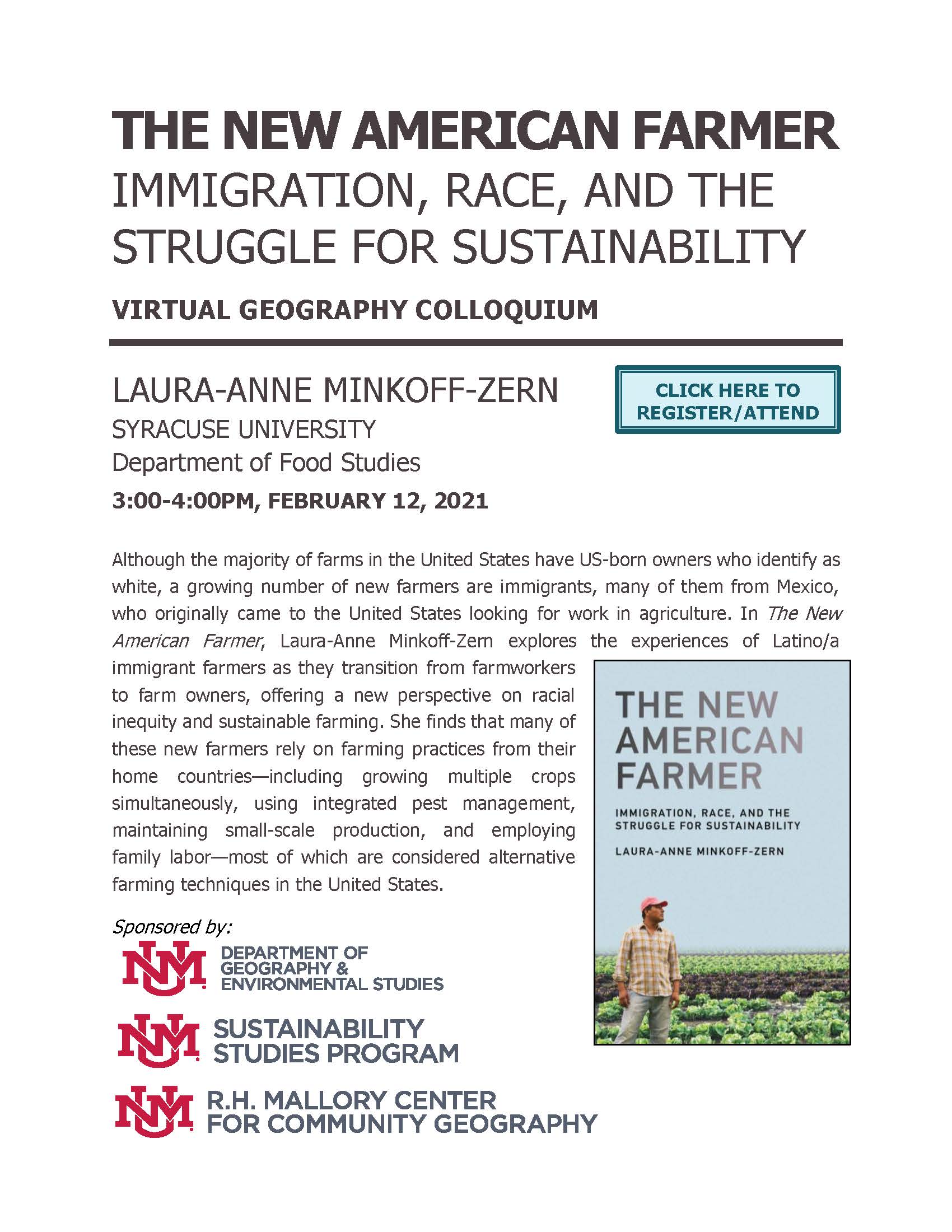 |
Eric Perramond Colorado College
Environmental Studies Program, Southwest Studies “Climate, Law, and New Mexico’s Water
in the 21st Century” Eric Perramond, a geographer,
is a professor of
Environmental Science and
Southwest Studies at
Colorado College and
recently published “Unsettled
Waters: Rights, Law, and
Identity in the American
West.” “Unsettled Waters” is
the first book on water
adjudications in the American
West. New Mexico envisioned
adjudication as a
straightforward accounting of
water rights as private
property. However,
adjudication resurfaced
tensions and created conflicts
among water sovereigns at
multiple scales. | | 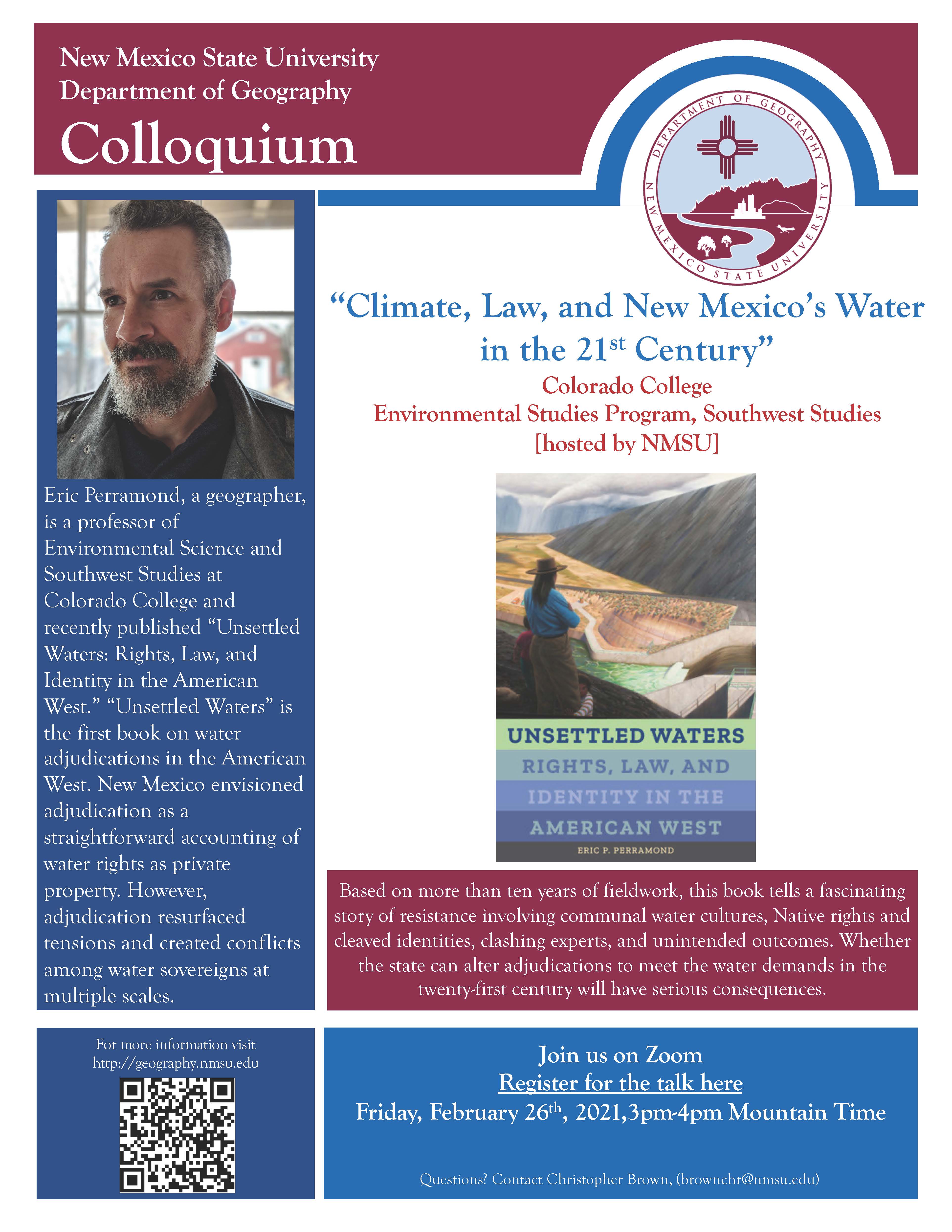 |
GERNOT PAULUS
CARINTHIA UNIVERSITY OF APPLIED SCIENCES
Department of Geoinformation and Environmental Technologies GISCIENCE MEETS ART
IN THE FOREST AT THE
WÖRTHERSEE SOCCER STADIUM
IN KLAGENFURT, AUSTRIA An interdisciplinary research cooperation created a "Digital 3D Twin" of the temporary art
installation "FOR FOREST in the Wörthersee Football Stadium" in Klagenfurt, Austria in September
2019. The aim of this applied research project was the complete, centimeter-precise digital 3D
surveying of this art intervention through an innovative combination of various state-of-the-art
geodata acquisition technologies. The technologies used included terrestrial laser scanning,
precision reference measurement with mobile DGPS (Differential Global Positioning System) and
a Total Station, high-resolution drone based airborne images and photogrammetric analyses.
With the temporary installation of a species-rich mixed Central European forest in the Wörthersee
football stadium, the art intervention FOR FOREST by Klaus Littmann not only created the largest
art intervention in public space in Austria, but also a unique controlled experimental laboratory
for the following exciting and
challenging scientific research questions
in the context of forestry & surveying
and 3D visualization. | | 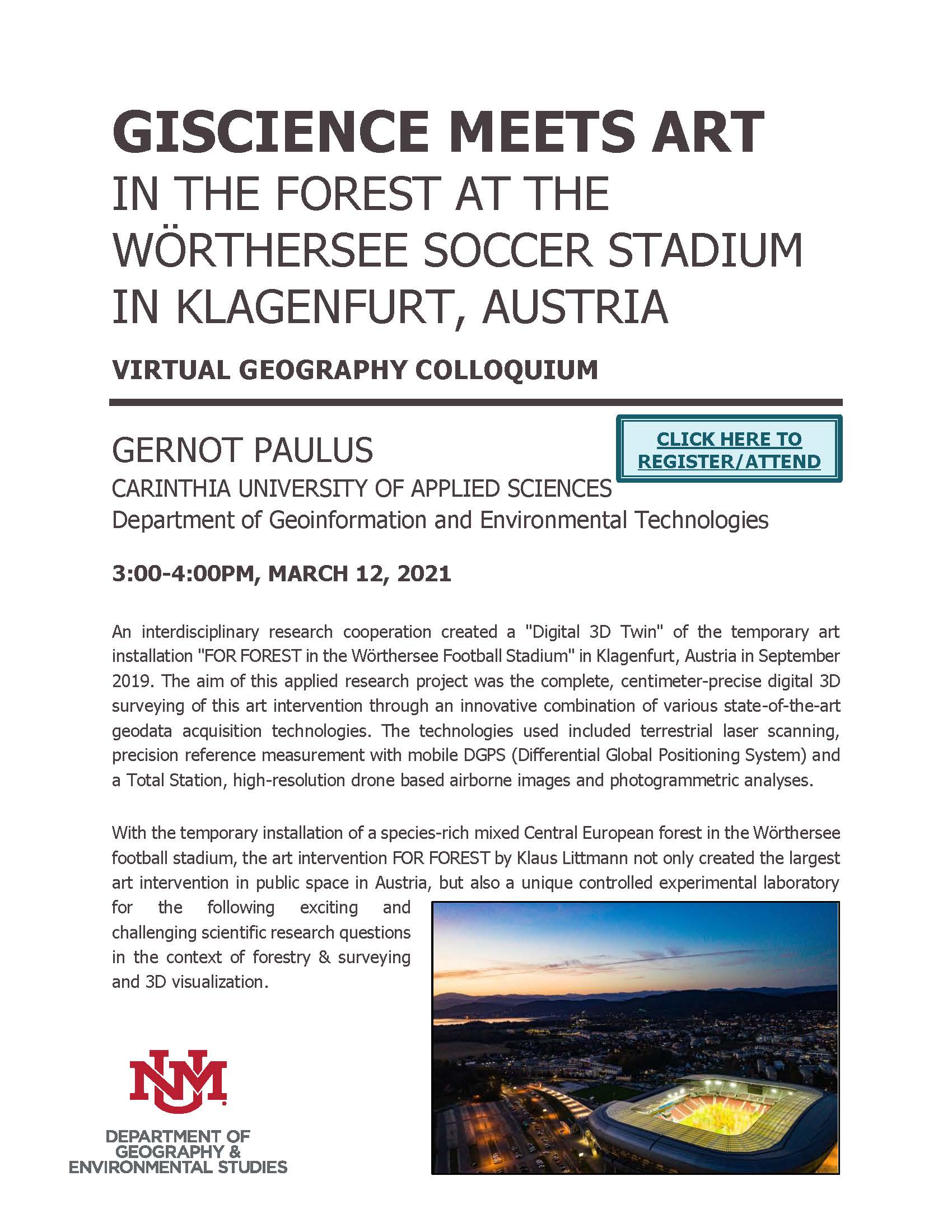 |
Dr. Emile Elias - Director, USDA
Southwest Climate Hub “Challenges and Opportunities: Responding to
the Impacts of Climate Change in the
Southwestern U.S.” Dr. Emile Elias is the director
of the USDA Southwest
Climate Hub – an organization
covering 5 states in the
Southwest. She has worked for
more than two decades at the
interface of water scarcity, water
quality, agricultural production
and natural resources with the
goal of supporting resilient
landscapes and communities.
Emile leads a Southwest Hub
team that is engaged in research
and science synthesis efforts,
tool development to support
informed decision-making, and
stakeholder outreach. She will
lead and interactive discussion
titled “Challenges and
opportunities: Responding to
the impacts of climate change
in the Southwestern U.S.” | | 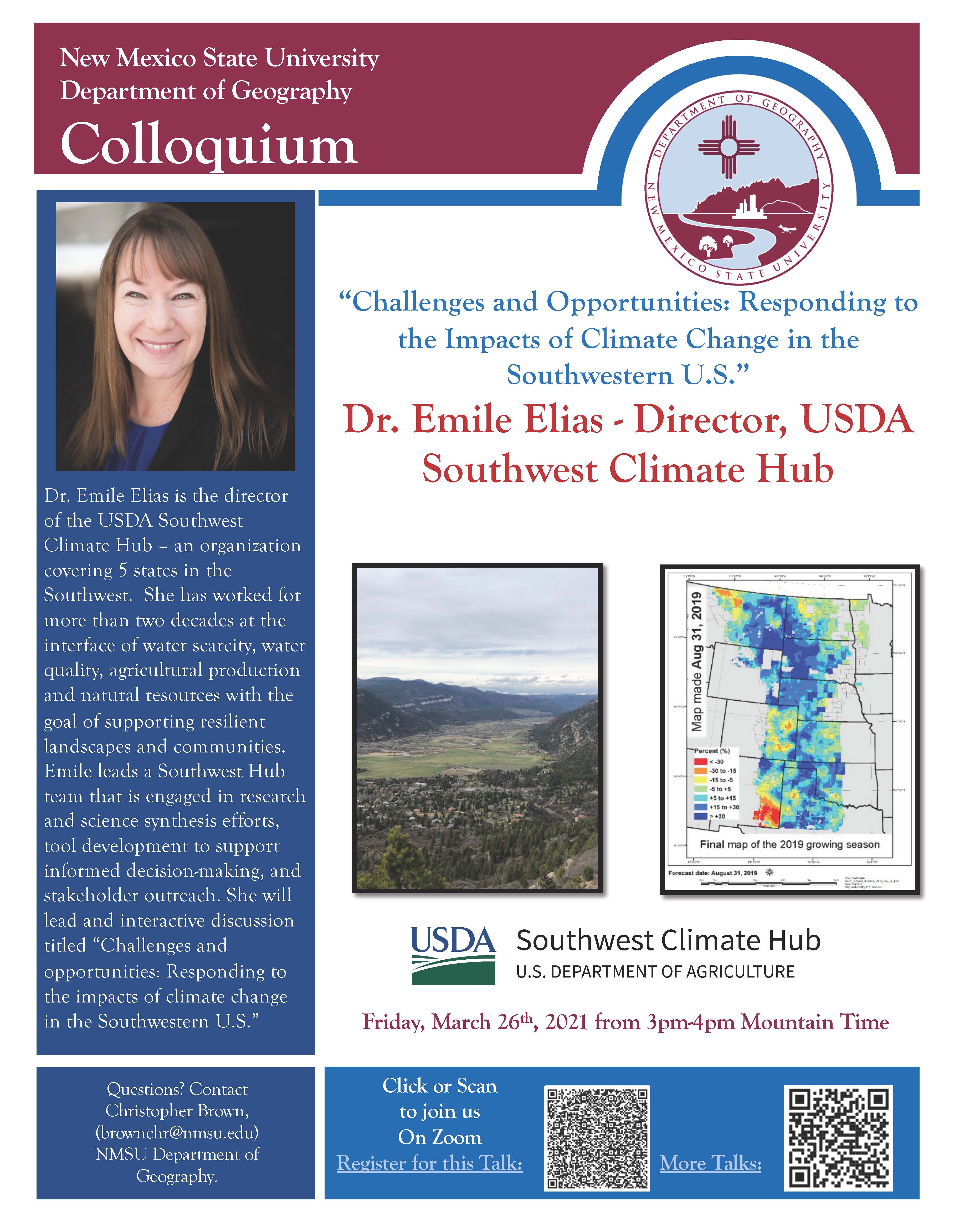 |
University of British Columbia
Professor Leila M. Harris Infrastructures of Inequality: justice and democracy at the margins This talk analyzes a decade of work on everyday processes
and politics related to water (and sanitation) infrastructure, conditions
and access in underserved communities of Accra, Ghana and Cape
dynamics.
Town, South Africa. The work traces conditions and everyday meanings
of uneven access to basic service infrastructures, particularly by
infrastructural conditions and politics. The work fits within the broader
highlighting narratives of belonging, exclusion, and inequity as key
to the ways that community members navigate and respond to
literature on critical infrastructural studies, and recent work that
seeks to understand water access and insecurity not only in relation
to public health, but broader notions of well-being, as well as
emotional-affective and socio-political considerations—from senses
of citizenship, to trust in government, and other key socio-political dynamics. | | 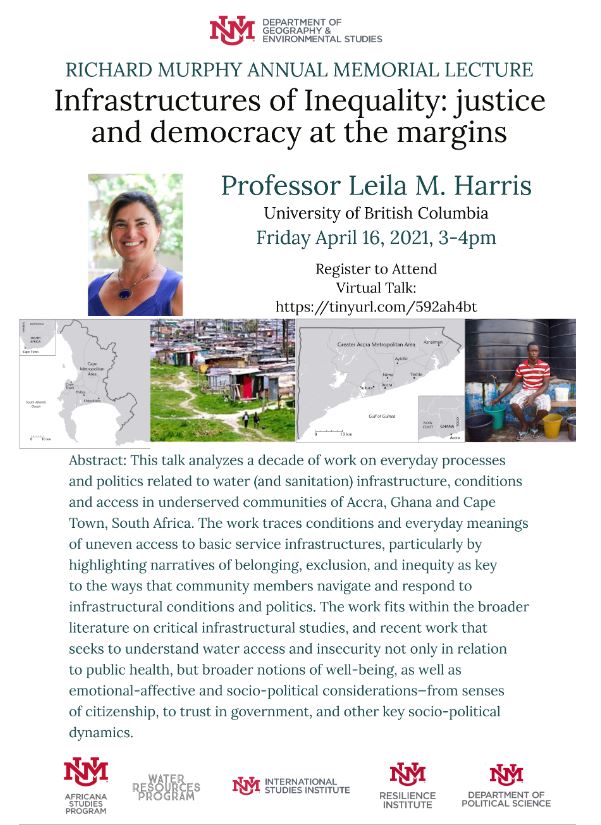 |
Dr. Michael DeMers - NMSU
Department of Geography “Innovations and Adaptations in Online
Geography Education” Dr. DeMers is Professor of
Geography at New Mexico State
University, specializing in
Geographic Information Science,
Geographic Education, and
Landscape Ecology. He has also
served as Past President of the
National Council for Geographic
Education. He is the 2018 winner of
the New Mexico Geographic
Information Council’s Wheeler Peak
Lifetime Achievement Award, a 2010
winner of the AAG Anderson Medal
of Honor in Applied Geography, an
Albert Nelson Marquis Lifetime
Achievement Honoree, and the 2011
New Mexico State University
Teaching Academy Teaching
Innovation Award. In his talk, Dr.
DeMers will give us the “inside
scoop” on “Innovations and
Adaptations in Online Geography
Education,” many of which he made
happen. | |  |
Michael Pease, Central Washington University Active Water Resource Management: Pariah or Blueprint for Western Water Management? Abstract: The western United States is plagued with chronic water shortages, frequent drought, and unclear water rights. Attempts to deal with shortages are a complicated web of federal, state, and local management. Many river basins suffer from imperfect data about water ownership and priority, constraining water managers during periods of water scarcity. The fallout from inadequate water planning is conflated by attributes of water rights being undefined. Considerable research has focused on watershed-level planning. Additional focus is needed on intergenerational planning. Daly referred to such long-range planning as "moral growth," and it could be considered a cornerstone of sustainable water use. It could also be considered a "third rail" of multi-scalar resource management. | | 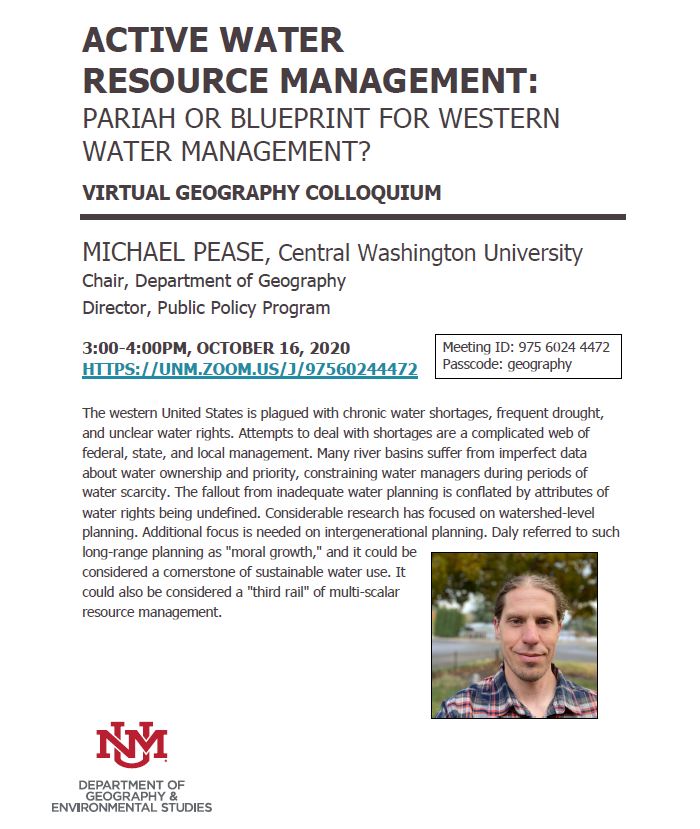 |
